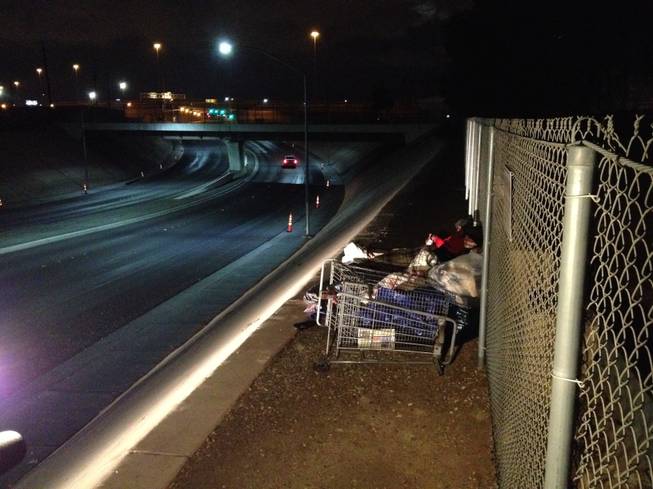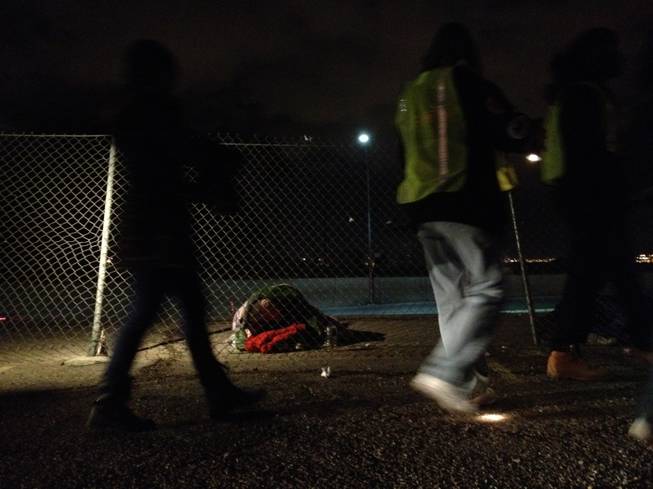
Ian Whitaker
Every year, volunteers count Las Vegas’ homeless.
Thursday, Jan. 29, 2015 | 2 a.m.
Groups of three and four grab bright green vests, clipboards and heavy flashlights from cardboard boxes in a downtown Las Vegas cafeteria.
Just after midnight Wednesday morning, the groups split up, each disappearing down their own darkened stretch of Las Vegas Boulevard.
In these groups, one member usually acts as a recorder. The others twist flashlights through locked gates and raise them high above their heads, stretching the light as far as it will go into alleys and dim corners. Usually all they find is a pile of rags or empty food boxes. But sometimes a volunteer will see a face peering back.
They’ll say something like, “One male, 18-years-old,” and the recorder will write it down.
This is how Las Vegas — and many other cities — counts its homeless.
The federally mandated census used to be done once every two years, said Tim Burch, head of Clark County’s social services, but now it’s every year.
Around 200 volunteers fan out from locations across the valley over the course of a few days to log the city’s street population. A few weeks later, other volunteers survey homeless people who live in shelters. The results of both efforts form the basis of a county report, which is forwarded to the federal Housing and Urban Development to stitch together a national picture of homelessness.
Burch has done the census five times. He organizes it from the ground level, clutching a walkie-talkie while watching his volunteers’ distant flashlight beams crawl up and down streets.
“Overall the trend is going down,” Burch said. “But what we’ve noticed is that the chronically homeless are staying out here longer and are sicker.”
Homeless people who live on the street for three years or more have on average three disabilities, Burch said. The census helps local officials like Burch figure out what kind of services are most in need, and informs federal administrators when they're allocating funding for things like transitional housing and mental health programs.
But all of the number-crunching comes weeks and months after the business of the census itself, called point-in-time counts, which involves volunteers scrambling up drainage ditches and over graffitied railroad tracks in search of what those in social services call “indigents.” Many are addicted to drugs or alcohol and some have mental health problems. The most serious cases require urgent medical attention, like a man that volunteer Marcus White found during a sweep of Washington Avenue. He was just sitting there, White said, with discolored feet.
“This is our everyday reality in the social service world,” Burch said. “You never get used to it — it’s always heartbreaking.”
One time, Burch said, he stumbled upon a pregnant woman with children sleeping in the shadow of a women’s shelter. She was too scared to actually go in, having been intimidated by her pimp and told she wouldn’t get help.
“It is a visual count, but for those of us that are professionals, when we see those things, we will intervene,” he said.

The count is an imprecise science; volunteers can’t physically walk every street in the entire county. A federal algorithm takes what they do tabulate and estimates a countywide number. During the height of the recession in 2009, it was 13,388. Last year it was 9,417. This year's number will take a few weeks to calculate.
Far more helpful are the comments volunteers hear from the homeless themselves. In surveys conducted at shelters after the census, officials can get a sense of who is homeless and why. Last year, for instance, the majority of the homeless were white and male. Almost 10 percent were military veterans. And almost 800 were children under 18.
“We get people in my office every single day, fresh off the Greyhound bus, who’ve seen the commercials, thinking they can come here, get a job and live on tips,” Burch said.
According to the 2014 survey, a quarter of homeless people were from out of state before they ended up homeless in Las Vegas. Around half said they became homeless because they couldn’t afford rent, didn’t have transportation, or had bad credit. Half also said it was the first time they had ever been homeless, and that losing their job was the reason they were forced onto the streets.
By the time White and Tyrone Thompson, a current Nevada Assemblyman and former homeless coordinator for the Southern Nevada Regional Planning Coalition, get back onto Main Street to turn in their numbers, the homeless have doubled. They are often hard to count because they move through different communities.
“People keep saying it’s not in their community,” Thompson said, “but it is.”

Join the Discussion:
Check this out for a full explanation of our conversion to the LiveFyre commenting system and instructions on how to sign up for an account.
Full comments policy